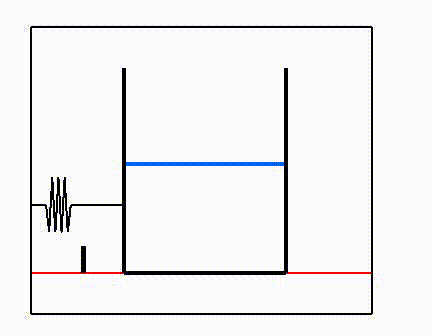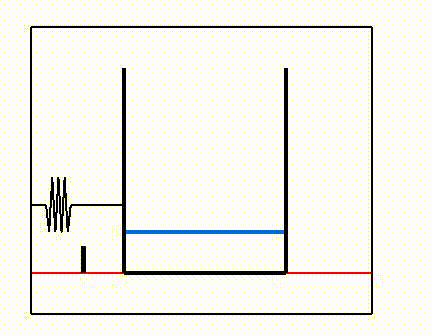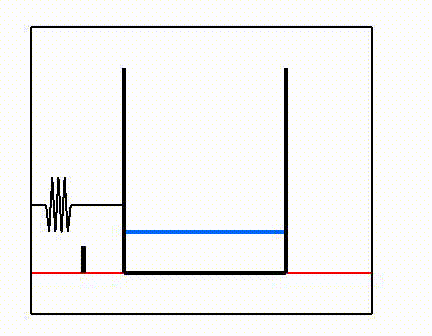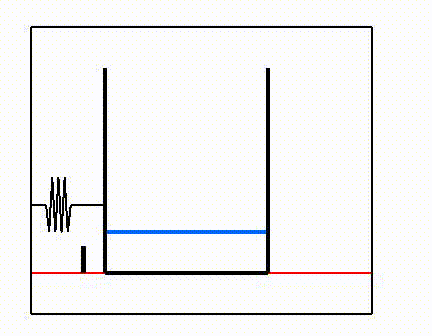Senior Lecturer in Mathematics
Department of Mathematics and Statistics
University of Exeter, Streatham Campus
Exeter EX4 4QF
ENGLAND

Shallow water sloshing in rotating vessels - 2D flowfield
New shallow-water equations, for sloshing in two dimensions (one horizontal and one vertical) in a vessel which is undergoing rigid-body motion in the plane, are derived. The planar motion of the vessel (pitch-surge-heave or roll-sway-heave) is exactly modelled and the only approximations are in the fluid motion. The flow is assumed to be inviscid but vortical, with approximations on the vertical velocity and acceleration at the surface. These equations improve previous shallow water models for sloshing. The model also contains the essence of the Penney-Price-Taylor theory for the highest standing wave. The surface shallow water equations are simulated using a robust implicit finite-difference scheme. Numerical experiments are reported, including simulations of coupled translation-rotation forcing, and sloshing on a Ferris wheel. Asymptotic results confirm that rotations should be of order h/L, where h is the mean depth and L is the vessel length, but translations can be of order unity, in the shallow water limit.
Alemi Ardakani H, Bridges TJ. (2012) Shallow-water sloshing in vessels undergoing prescribed rigid-body motion in two dimensions, European Journal of Mechanics, B/Fluids, volume 31, no. 1, pages 30-43, DOI:10.1016/j.euromechflu.2011.08.004.
H. Alemi Ardakani & T.J. Bridges. Shallow-water sloshing in rotating vessels undergoing prescribed rigid-body motion in two dimensions -- the extended version. Technical Report (2010) [PDF]
H. Alemi Ardakani & T.J. Bridges. Comparison of the numerical scheme with previous rotating SWE numerics of Dillingham, Armenio & La Rocca, Huang & Hsiung Technical Report, (2010) [PDF]




Shallow water sloshing in rotating vessels - 3D flowfield
New shallow-water equations, for sloshing in three dimensions (two horizontal and one vertical) in a vessel which is undergoing rigid-body motion in 3-space, are derived. The rigid-body motion of the vessel (roll-pitch-yaw and/or surge-sway-heave) is modelled exactly and the only approximations are in the fluid motion. The flow is assumed to be inviscid but vortical, with approximations on the vertical velocity and acceleration at the surface. These equations improve previous shallow water models. The model also extends the essence of the Penney-Price-Taylor theory for the highest standing wave. The surface shallow water equations are simulated using a split-step implicit alternating direction finite-difference scheme. Numerical experiments are reported, including comparisons with existing results in the literature, and simulations with vessels undergoing full three-dimensional rotations.

Alemi Ardakani H, Bridges TJ. (2011) Shallow-water sloshing in vessels undergoing prescribed rigid-body motion in three dimensions, Journal of Fluid Mechanics, volume 667, pages 474-519, DOI:10.1017/S0022112010004477.
H. Alemi Ardakani & T.J. Bridges. Shallow-water sloshing in vessels undergoing prescribed rigid-body motion in three dimensions Technical Report (2009) (extended version with colour figures) [PDF]
Dynamic coupling between fluid sloshing and vehicle motion
The coupled motion between shallow water sloshing in a moving vehicle and the vehicle dynamics is considered. The movement of the vessel is restricted to horizontal motion. Motivated by the theory of Cooker (1994), a new derivation of the coupled problem in the Eulerian fluid representation is given. The aim is to simulate the nonlinear coupled motion numerically, but the nonlinear coupling causes difficulties. These difficulties are resolved by transforming to the Lagrangian represention of the fluid motion. In this representation an explicit, robust, simple numerical algorithm, based on the Störmer-Verlet method, is proposed. Numerical results of the coupled dynamics are presented. The forced motion (neglecting the coupling) leads to quite complex fluid motion, but the coupling can be a stabilising influence.
Alemi Ardakani H, Bridges TJ. (2010) Dynamic coupling between shallow-water sloshing and horizontal vehicle motion, European Journal of Applied Mathematics, volume 21, no. 6, pages 479-517, DOI:10.1017/S0956792510000197.
H. Alemi Ardakani & T.J. Bridges. Symplecticity of the Stormer-Verlet algorithm for coupling between the shallow water equations and horizontal vehicle motion. Technical Report (2010) [PDF]
M.J. Cooker. Water waves in a suspended container, Wave Motion 20 385-395 (1994).





Fluid-vessel coupling for a rotating vessel
The coupled liquid-vessel motion of a rotating vessel and shallow water sloshing is considered. The equations for the fluid are the rotating shallow water equations derived in Alemi Ardakani & Bridges (2009). These equations are coupled to an equation for the rotational motion of the vehicle. New equations are derived, starting with a variational formulation and the shallow-water approximation. As a test case the "pendulum slosh" problem is studied. In the pendulum slosh problem the vehicle is a pendulum with the pendulum bob containing fluid. The coupling changes the natural frequencies of the rigid body pendulum and the fluid motion in a fixed vessel. Numerical simlulations are reported.

H. Alemi Ardakani & T.J. Bridges. Dynamic coupling between shallow-water sloshing and a vehicle undergoing planar rigid-body rotation, Technical Report (2010) [PDF]
The Euler equations relative to a moving frame
In this technical report the details of the construction of the apparent accelerations, which appear in the Euler equations when viewed from a body fixed 3D moving frame, are presented. A moving frame has been widely used in the study of sloshing. However, there are small subtleties that have been overlooked in previous derivations, and therefore a detailed derivation is presented here.
H. Alemi Ardakani & T.J. Bridges. The Euler equations in fluid mechanics relative to a rotating-translating reference frame, Technical Report (2010) [PDF]

Review of Dillingham, Falzarano & Pantazopoulos SWEs
Two derivations of the shallow water equations (SWEs) for fluid in a vessel that is undergoing a general rigid-body motion in three dimensions first appeared in the literature at about the same time, given independently by Pantazopoulos (1987,1988) and Dillingham & Falzarano (1986). However both derivations follow the same strategy. Their respective derivations are an extension of the formulation for two-dimensional shallow water flow in a rotating frame in Dillingham (1981). Their idea is to start with the classical SWEs; then deduce the apparent accelerations of the body frame relative to an inertial frame. Then the gravitational force is replaced by an average of the vertical accelerations and approximations for horizontal accelerations are subsituted into the right-hand side of the horizontal momentum SWEs. The purpose of this report is to determine the precise approximations used in the derivation in order to compare with the new shallow-water equations found in Alemi Ardakani & Bridges (2009).

H. Alemi Ardakani & T.J. Bridges. Review of the Dillingham, Falzarano & Pantazopoulos three-dimensional shallow-water equations. Department of Mathematics Report (2009) [PDF]
J.T. Dillingham & J.M. Falzarano. Three-dimensional numerical simulation of green water on deck, Third International Conference on the Stability of Ships and Ocean Vehicles. Gdansk, Poland (1986).
M.S. Pantazopoulos. Three-dimensional sloshing of water on decks, Marine Technology 25 253-261 (1988).
M.S. Pantazopoulos. Numerical solution of the general shallow water sloshing problem, PhD Thesis: University of Washington, Seattle (1987).
Review of Huang-Hsiung rotating SWEs
In the literature there are two strategies for deriving the shallow water equations (SWEs) relative to a rotating frame in three dimensions. The first -- the strategy of Dillingham, Falzarano & Pantazopoulos -- is reviewed in the report cited above. The second strategy is that of Huang & Hsiung (1996). In this report their derivation is reviewed identifying the key assumptions. The Huang-Hsiung derivation is then contrasted with a new third strategy for deriving SWEs using the surface equations derived in Alemi Ardakani & Bridges (2009).

H. Alemi Ardakani & T.J. Bridges. Review of the Huang-Hsiung three-dimensional shallow-water equations. Department of Mathematics Report (2009) [PDF]
H. Alemi Ardakani & T.J. Bridges. Review of the Huang-Hsiung two-dimensional shallow-water equations. Department of Mathematics Report (2009) [PDF]
Z. Huang & C.C. Hsiung. Nonlinear shallow-water flow on deck, J. Ship Research 40 303-315 (1996).
Z. Huang. Nonlinear shallow-water flow on deck and its effect on ship motion, PhD Thesis, Technical University of Novia Scotia (1995).
Other technical reports on shallow water sloshing
H. Alemi Ardakani & T.J. Bridges. Asymptotics of (SWE-1) and (SWE-2) in the shallow water limit in three dimensions. Department of Mathematics Report (2010) [PDF]
H. Alemi Ardakani & T.J. Bridges. Shallow water sloshing in rotating vessels: details of the numerical algorithm, Department of Mathematics Report (2009) [PDF]
H. Alemi Ardakani & T.J. Bridges. Review of the Armenio-LaRocca two-dimensional shallow-water equations, Department of Mathematics Report (2009) [PDF]
H. Alemi Ardakani & T.J. Bridges. Yaw forcing with the vessel position also plotted -- towards a video of 3D sloshing, Department of Mathematics Report (2009) [PDF]
H. Alemi Ardakani & T.J. Bridges. Coupled roll-pitch motions: 1:2 resonance simulations, Department of Mathematics Report (2010) [PDF]
H. Alemi Ardakani & T.J. Bridges. Review of the 3-2-1 Euler angles: a yaw-pitch-roll sequence, Department of Mathematics Report (2010) [PDF]

